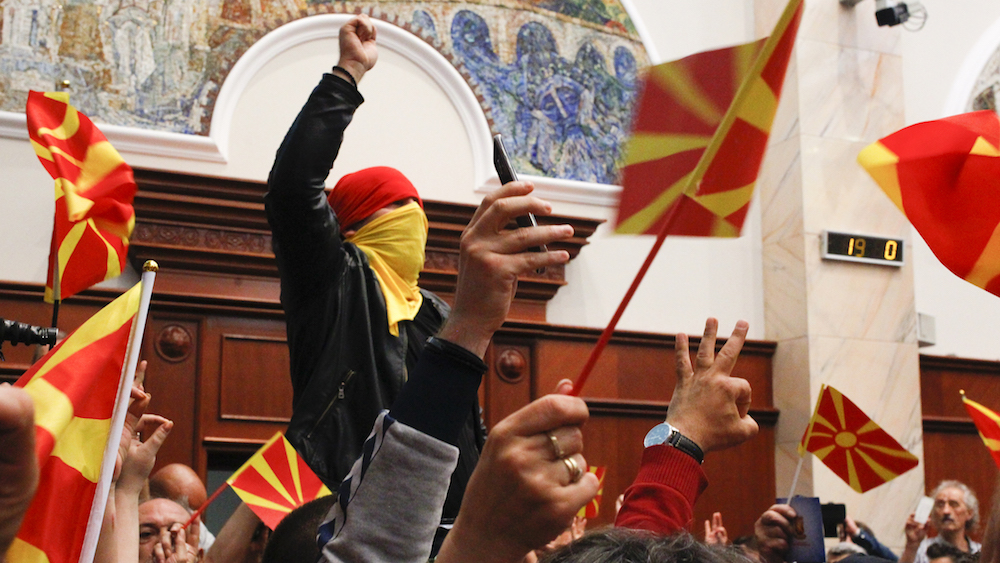Rising political tensions in Bosnia-Herzegovina and Macedonia are sparking concerns in Europe and the United States, and rumors are mounting that the region is on the brink of war once again. What is really going on?
At first sight it looks like business as usual in Bosnia. True, ethnonationalist parties there have sharpened their rhetoric and threatened to paralyze state institutions – but they have been doing so for years. In Macedonia, on the other hand, we are witnessing a rather unusual development: in images broadcast around the world, an angry mob of VMRO supporters, a Macedonian nationalist party, stormed parliament to block a coalition between the Social Democratic Party and Albanian ethnic minority parties. The Albanian parties’ MPs were attacked and beaten, but they reacted to the provocation in a conciliatory manner, preventing an ethnic conflict. Still, the EU and NATO urged calm as the international community raised alarm bells.
These tensions have sparked serious concerns in the West, although – paradoxically – they have actually been triggered by initiatives coming from the West itself. Tensions in Bosnia-Herzegovina and Macedonia flared after op-ed articles appeared in Foreign Affairs and the New York Observer, written by former British diplomat Timothy Less and John R. Schindler, previously of the US National Security Agency (NSA), respectively. This development can hardly be cast off as coincidental, particularly given the fact that Balkan leaders are easily played one against another when they detect that the West is considering a geopolitical reshuffle in the region. Since they are already well accustomed to escalating inter- and intra-state tensions for their own political gain, Balkan leaders can readily assemble such tensions as soon as they see signs in the US media – supported, of course, by the authority of “experts.”
These two articles advocate a total redesign of the existing state boundaries in the Balkans: A Greater Serbia would appropriate the existing Serb entity in Bosnia-Herzegovina and the internationally-recognized Republic of Montenegro; Greater Croatia would usurp a future Croatian entity in Bosnia-Herzegovina; Greater Albania, meanwhile, should envelop both Kosovo and the western part of Macedonia. All these territorial redesigns would end the chaos in Bosnia and Macedonia and bring about lasting peace and stability in the region.
Of course, it is easy to claim that this approach has nothing to do with the policies of the authors’ former employers. However, certain circles within the foreign policy establishment in both the United Kingdom and the United States have repeatedly advocated the very same ideas – i.e. partition of multiethnic states and creation of monoethnic greater states – as a path toward lasting stability in the Balkans, with Bosnia and Macedonia’s disappearance as collateral damage. These narratives have been circulating in the back halls of London and Washington for decades.
They would argue that the creation of monoethnic states contributes to the region’s stability, but this claim has always served as a pretext for implementing what many in these circles consider a fundamental geopolitical doctrine – the so-called Heartland Theory by Sir Halford J. Mackinder (1861-1947). The British academic and politician, seen as one of the founding fathers of geopolitics, famously proclaimed: “Who rules East Europe commands the Heartland; who rules the Heartland commands the World-Island; who rules the World-Island commands the world.”
Mackinder’s doctrine argues for the long-term destabilization of the territorial belt between Germany and Russia (consisting of Eastern Europe and the Balkans) as its primary geopolitical goal, in order to prevent these two continental powers from establishing a direct territorial link, which would enable them to gain control over the entire Heartland, and thus over the entire world.
Beware of Redrawing Maps
Ostensibly, these narratives are rooted in what is considered a plausible presupposition: as long as greater state projects remain unrealized, nationalist tensions will continue to act as a destabilizing force. Yet history has clearly demonstrated that this theory is a simple fallacy. The concept of ethnonational states has always led to deep instability wherever applied. Such territories cannot be created without extreme coercion and violence over populations that do not “belong” – including ethnic cleansing and genocide. Solving national issues by creating ethnically cleansed greater states is a strategy that spawns permanent instability.
What’s more, such a scenario would be politically unacceptable, unless presented as an alternative to a full-scale war. But no state in the Balkans has the capacities or resources – military, financial, or demographic – to wage such a war, and their leaders are too aware of this to even try. Therefore, the only remaining option is to create an atmosphere that simulates the immediate threat of war by stoking nationalist sentiments between and within Balkan states. Of course, these tensions have already been present since 1990, but now they are evolving into a festering chaos, creating the illusion of an imminent armed conflict.
In this simulated atmosphere of “inevitable war,” a radical geopolitical reconfiguration of the entire Balkans can quickly become politically acceptable if it is seen as the only peaceful solution. All that is left is to offer to implement this reconfiguration at an international peace conference, like the one held in Dayton, Ohio, in 1995.
It comes, therefore, as no surprise that a conference on the Western Balkans has been scheduled for 2018 in London. The specter of renewed conflict in the region may grant a geopolitical redesign the legitimacy and urgency needed to be implemented at this conference.
Of course, such a redesign will only lead to further resentment and volatility in the Balkans and Eastern Europe and trigger more instability across the continent. It is in the EU’s best interest to prevent the continent’s destabilization, and Brussels has no choice but to clearly reject such greater state projects and assume responsibility – both political and legal – for protecting the sovereignty and territorial integrity of all Balkan and Eastern European states, from Bosnia and Macedonia to Ukraine, Georgia, and the Baltic states.







